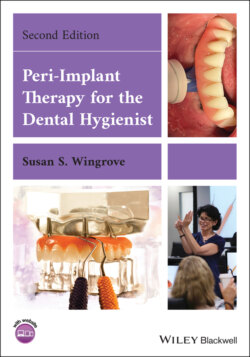Читать книгу Peri-Implant Therapy for the Dental Hygienist - Susan S. Wingrove - Страница 18
Implants
ОглавлениеOver the past 30 years, research has validated the success of osseointegrated implants as a viable alternative to fixed or removable prosthetic restorations (Figure 1.8) (4). Implant placement in the premolar and molar are 95% successful and are considered the first choice in tooth‐replacement options (5, 6). This is supported by the dental literature for many implant systems in every area of the mouth (7). According to Michael Tischler et al. (8, 9), because of “the amount of edentulism currently documented, it is essential for clinicians to incorporate dental implants into everyday practice.” The American Association of Oral and Maxillofacial Surgeons report that 69% of adults between ages 35 and 44 years have lost at least one permanent tooth and 43% of adults over the age of 65 years old are missing six or more teeth due to tooth decay, periodontal disease, a failed root canal, or trauma (8, 9).
Figure 1.8 Titanium and ceramic (zirconia) implant examples.
Courtesy of Straumann.
As hygienists, these changes have evolved into a new phase of maintenance care for our patients. Before we can understand the new protocols for our maintenance appointments, an understanding of the basics of implants and why most implants are made from titanium alloy is necessary. The choice of which type of implant to use will be in the hands of the surgeon, titanium or ceramic. Hygienists need an understanding of the component parts. The main component parts of an implant are the fixture (design, length, shape, diameter, and surface), transmucosal abutment, and the restoration/prosthesis.
Why is titanium metal used for dental implants? Titanium metal is chosen because of its biocompatibility (not rejected by the human body), formation of titanium dioxide (TiO2) layer that prevents corrosion of the titanium implant. Other reasons that also make quite a remarkable list: it is strong, lightweight, corrosion resistant, nontoxic, nonferromagnetic, biocompatible, long lasting, and osseointegrative (joins to human bone), and its flexibility and elasticity are similar to that of human bone. Titanium alloy which is what the majority of dental implants are made from are mainly TiAl6V4 otherwise known as medical grade 5 and grade 23 for the greatest fracture resistance.
Another point to call the patient's attention to regarding titanium implants is the nonferromagnetic quality of titanium. The benefit of being nonferromagnetic allows for patients with titanium implants to safely be examined with magnetic resonance imaging ( MRI s) and national magnetic resource imaging ( NMRI s). One of the biggest benefits is the osseointegration of titanium and the human body, allowing for the patient's own natural bone to integrate and attach to an artificial device.
Titanium implants have a rough, smooth, and/or coated surfaces to speed up the osseointegration process (Figure 1.9). Types of treated surfaces are always evolving with the goal being to provide a biologically compatible surface to attract the bone to integrate to the implant. Some examples of surface treatments are hydroxyapatite (HA), the crystalline phase of calcium phosphate found naturally in bone mineral that is sprayed onto the implants, and titanium plasma sprayed (TPS), which simply means a heat/spray technique used in the industry to apply to the titanium implant surface. These coatings are sprayed on the implant body at the factory, placed in sterile container, and sealed. According to Vallecillo Capilla et al. (10), “long term success rates were outstanding for HA‐coated implants and acceptable for TPS‐coated implants after 5 years” (10).
Ceramic, zirconia‐based implants, and abutments have emerged as a metal‐free, tooth‐like color, and light transmission especially preferred for aesthetic zone but can be placed in other zones. Ceramic implants have no oxide layer, a nontoxic alternative, and treatment of choice for patients who want or need a metal‐free option. (11) Zirconia implants are machined (ZrO2m) or sandblasted (rough ZrO2r). The ZrO2r implants, have a rough surface and have shown in the literature to achieve a higher stability in bone (12) (Figure 1.10).
Figure 1.9 SEM titanium implant surface.
Courtesy of PDT, Inc.
There is still some confusion on how ceramic, zirconia‐based implants, are considered metal‐free with zirconium in the composition. Zirconium is by definition the metallic form of the element Zr, a grayish‐white transition metal. Zirconium dioxide (ZrO2) by contrast is a white crystalline oxide of zirconium also called zirconoxide and is 100% ceramic material. Metals are highly reactive and atoms of metal elements such as zirconium collide with atoms of nonmetallic element like oxygen forming an ionic compound ZrO2. This allows for changes in properties, such as the white color, minimal electrical conductivity, and relatively no reactive response.
When you compare titanium versus ceramics implants besides the metal and nonmetal differences, ceramic implants do not have an oxide layer in comparison to titanium that has an oxide layer that can be removed by multiple factors. While the surface coatings added to titanium implants is an advantage for osseointegration, it can have its own disadvantage if it is removed with the oxide layer due to mechanical or chemical means. More on this in Chapter 7, titanium dissolution particles that can lead to implant corrosion complications.
